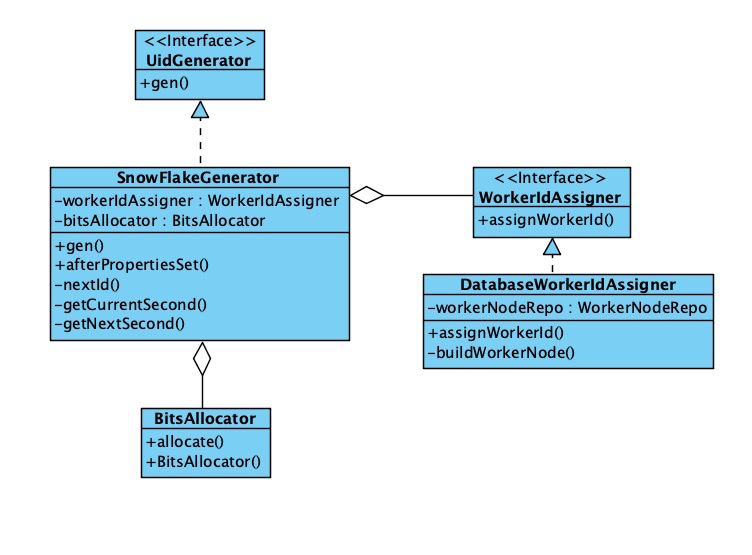基于Spring Boot的可直接运行的分布式ID生成器的实现以及SnowFlake算法详解
背景
最近对snowflake比较感兴趣,就看了一些分布式唯一ID生成器(发号器)的开源项目的源码,例如百度的uid-generator,美团的leaf。大致看了一遍后感觉uid-generator代码写的要更好一些,十分的精炼,短小精悍。
正好手头有个任务要搞个发号器,百度的这个源码是不能直接运行起来提供服务的,为了练练手,就把百度的uid-generator迁移到spring boot上重写了一遍。
代码基本一模一样,就做了一些工程化的东西,让uid-generator能以服务的形式跑起来,通过http接口对外提供服务。
可运行的代码地址:点这里
SnowFlake数据结构
这里借用一下uid-generator的图:

这一个结构就是一个snowflake算法里的id,共计64位,就是一个long。
- sign是一个恒为0的值,是为了保证算出的id恒为正数。
- delta seconds (28 bits)
当前时间,相对于时间基点"2016-05-20"的增量值,单位:秒,最多可支持约8.7年。时间基点是自己配置的。28位即最大表示2^28的数值的秒数,换算一下就是8.7年左右。
- worker id (22 bits)
机器id,最多可支持约420w次机器启动。内置实现为在启动时由数据库分配。420w = 2^22
- sequence (13 bits)
每秒下的并发序列,13 bits可支持每秒8192个并发,即2^13个并发
这些位数都是可以改变的,对于很多公司来说,28位 delta seconds带来的8.7年的最大支持时间是可预期的不够用的,而22bit的worker id和13bit的sequence则是远远超出可预期的业务场景的,那么就可以自由的根据自己的需求,对这三个参数进行调整。
例如,{"workerBits":20,"timeBits":31,"seqBits":12}这样的配置可以68年,100W次重启,单机每秒4096个并发的情况,个人感觉还是比较合适的。
snowflake的实现有很多种方式,不过思想上都是一样的。
SnowFlake发号实现
在了解SnowFlake的数据结构后,就可以来看看具体是如何生成ID的了。
其实这个过程,就是往delta seconds,sequence,worker id三个结构里填充数据的过程。
整体类图如下:

SnowFlakeGenerator就是基于SnowFlake算法的UidGenerator的实现类,SnowFlake的实现就是在这个类里;
BitsAllocator就是对SnowFlake 的ID进行位操作的共聚类;
DatabaseWorkerIdAssigner就是一个基于DB自增的worker id 分配器的实现。
BitsAllocator
这个类是进行一些位操作的工具类,给每一个id 的delta seconds,sequence,worker id赋值就是通过这个类来实现的。这个类有以下成员变量:
/**
* Total 64 bits
*/
public static final int TOTAL_BITS = 1 << 6; /**
* Bits for [sign-> second-> workId-> sequence]
*/
private int signBits = 1;
private final int timestampBits;
private final int workerIdBits;
private final int sequenceBits; /**
* Max value for workId & sequence
*/
private final long maxDeltaSeconds;
private final long maxWorkerId;
private final long maxSequence; /**
* Shift for timestamp & workerId
*/
/**
* timestamp需要位移多少位
*/
private final int timestampShift;
/**
* workerId需要位移多少位
*/
private final int workerIdShift;
其他字段都好说,看名称和注释都能明白。最下面俩shift,可能现在看着有些摸不着头脑,不过看后面的赋值过程就知道什么叫“shift”了
构造器:
/**
* Constructor with timestampBits, workerIdBits, sequenceBits<br>
* The highest bit used for sign, so <code>63</code> bits for timestampBits, workerIdBits, sequenceBits
*/
public BitsAllocator(int timestampBits, int workerIdBits, int sequenceBits) {
// make sure allocated 64 bits
int allocateTotalBits = signBits + timestampBits + workerIdBits + sequenceBits;
Assert.isTrue(allocateTotalBits == TOTAL_BITS, "allocate not enough 64 bits"); // initialize bits
this.timestampBits = timestampBits;
this.workerIdBits = workerIdBits;
this.sequenceBits = sequenceBits; // initialize max value
//-1 是111111111(64个1)
//先将-1左移timestampBits位,得到111111100000(timestampBits个零)
//然后取反,得到00000....1111...(timestampBits)个1
//等价于2的timestampBits次方-1
this.maxDeltaSeconds = ~(-1L << timestampBits);
this.maxWorkerId = ~(-1L << workerIdBits);
this.maxSequence = ~(-1L << sequenceBits); // initialize shift
this.timestampShift = workerIdBits + sequenceBits;
this.workerIdShift = sequenceBits;
}
也很简单,重点就在 “~(-1L << timestampBits) ”这样一坨操作,可能理解起来会有些困难。这是一连串的位操作,这里进行一下分解:
- -1 左移 timestampBits 位,实际的二进制看起来是11111111......00000...(最前面的1是最高位,表示负数;后面有timestampBits个0)
- 对-(2^timestampBits)进行取反操作,的到了2的timestampBits次方-1。实际的二进制看起来就是1111(timestampBits个1)
这一通操作其实也就相当于2的timestampBits次方-1,也就是timestampBits位二进制最大能表示的数字,不过是用位运算来做的。如果不懂二进制的位移和取反,可以百度“位操作”补充一下基础,这里就不展开了。
分配操作:
/**
* Allocate bits for UID according to delta seconds & workerId & sequence<br>
* <b>Note that: </b>The highest bit will always be 0 for sign
*
* 这里就是把不同的字段放到相应的位上
* id的总体结构是:
* sign (fixed 1bit) -> deltaSecond -> workerId -> sequence(within the same second)
* deltaSecond 左移(workerIdBits + sequenceBits)位,workerId左移sequenceBits位,此时就完成了字节的分配
* @param deltaSeconds
* @param workerId
* @param sequence
* @return
*/
public long allocate(long deltaSeconds, long workerId, long sequence) {
return (deltaSeconds << timestampShift) | (workerId << workerIdShift) | sequence;
}
这里就是对delta seconds,sequence,worker id三个结构进行赋值的地方了,核心代码之一。可以再看一下最上面的图,sequence是在最右侧(最低位),所以sequence不用做位移,直接就是在对的位置;
而workerId,需要左移workerIdShift才能到正确的位置。workerIdShift看上面的构造器,就是sequenceBits,就是sequence的位数;
deltaSeconds 左移timestampShift位,也就是workerIdBits + sequenceBits;
然后对这三个位移后的值进行“或”操作,就把正确的值赋到正确的位数上了。
DatabaseWorkerIdAssigner
SnowFlake中,deltaSeconds依赖时间戳,可以通过系统获取;sequence可以通过自增来控制;这俩字段都是项目可以自给自足的,而WorkerId则必须还有一个策略来提供。
这个策略要保证每次服务启动的时候拿到的WorkerId都能不重复,不然就有可能集群不同的机器拿到不同的workerid,会发重复的号了;
而服务启动又是个相对低频的行为,也不影响发号性能,所以可以用DB自增ID来实现。
DatabaseWorkerIdAssigner就是依赖DB自增ID实现的workerId分配器。
代码就不贴了,就是个简单的save然后取到DB的自增ID。
SnowFlakeGenerator
这里就是控制发号逻辑的地方了。
先看看成员变量和初始化部分:
@Value("${snowflake.timeBits}")
protected int timeBits = 28;
@Value("${snowflake.workerBits}")
protected int workerBits = 22;
@Value("${snowflake.seqBits}")
protected int seqBits = 13;
@Value("${snowflake.epochStr}")
/** Customer epoch, unit as second. For example 2016-05-20 (ms: 1463673600000)*/
protected String epochStr = "2016-05-20";
protected long epochSeconds = TimeUnit.MILLISECONDS.toSeconds(1463673600000L);
@Autowired
@Qualifier(value = "dbWorkerIdAssigner")
protected WorkerIdAssigner workerIdAssigner;
/** Stable fields after spring bean initializing */
protected BitsAllocator bitsAllocator;
protected long workerId;
/** Volatile fields caused by nextId() */
protected long sequence = 0L;
protected long lastSecond = -1L;
@PostConstruct
public void afterPropertiesSet() throws Exception {
bitsAllocator = new BitsAllocator(timeBits,workerBits,seqBits);
// initialize worker id
workerId = workerIdAssigner.assignWorkerId();
if(workerId > bitsAllocator.getMaxWorkerId()){
throw new RuntimeException("Worker id " + workerId + " exceeds the max " + bitsAllocator.getMaxWorkerId());
}
if (StringUtils.isNotBlank(epochStr)) {
this.epochSeconds = TimeUnit.MILLISECONDS.toSeconds(DateUtils.parseByDayPattern(epochStr).getTime());
}
log.info("Initialized bits(1, {}, {}, {}) for workerID:{}", timeBits, workerBits, seqBits, workerId);
}
@Value注入的都是配置文件里读取的值。
afterPropertiesSet里,将配置文件读取到的值传递给BitsAllocator,够造出一个对应的BitsAllocator;
然后生成一个workerId(插入一条DB记录),初始化过程就完成了。
再看核心发号控制逻辑:
/**
* Get UID
*
* @return UID
* @throws UidGenerateException in the case: Clock moved backwards; Exceeds the max timestamp
*/
protected synchronized long nextId() {
long currentSecond = getCurrentSecond(); // Clock moved backwards, refuse to generate uid
//todo 时钟回拨问题待解决
if (currentSecond < lastSecond) {
long refusedSeconds = lastSecond - currentSecond;
throw new UidGenerateException("Clock moved backwards. Refusing for %d seconds", refusedSeconds);
} // At the same second, increase sequence
//同一秒内的,seq加一
if (currentSecond == lastSecond) {
//seq 加一,如果大于MaxSequence,就变成0
//如果大于MaxSequence 就是seq能取到的最大值,二进制(seqBits -1)位全是1
sequence = (sequence + 1) & bitsAllocator.getMaxSequence();
// Exceed the max sequence, we wait the next second to generate uid
//号发完了,等到下一秒
if (sequence == 0) {
currentSecond = getNextSecond(lastSecond);
} // At the different second, sequence restart from zero
} else {
//新的一秒,重新开始发号
sequence = 0L;
}
lastSecond = currentSecond;
// Allocate bits for UID
return bitsAllocator.allocate(currentSecond - epochSeconds, workerId, sequence);
}
注意这是个synchronized方法,这是关键。
getCurrentSecond就是获取当前以秒为单位的时间戳;
sequence计算逻辑
如果currentSecond和lastSecond一样,那说明本次发号请求不是本秒的第一次,只要将sequence直接+1即可;如果+1后大于了MaxSequence(这里会用& bitsAllocator.getMaxSequence()设置为0),那说明本秒的sequence已经用完了,此时请求已经超出了本秒系统的最大吞吐量,这里需要调用getNextSecond(详见github),来等待到下一秒;
如果currentSecond和lastSecond不一样,说名本次请求是全新的一秒,这时候sequence设置为0即可。
deltaSecond计算逻辑
就是currentSecond - epochSeconds,当前时间减去初始时间的秒数。
此时,workerId,deltaSecond,sequence都已经确定了具体的值,然后调用bitsAllocator.allocate方法,就可以生成一个全新的ID了,至此发号完成。
基于Spring Boot的可直接运行的分布式ID生成器的实现以及SnowFlake算法详解的更多相关文章
- Spring Boot 2.x基础教程:进程内缓存的使用与Cache注解详解
随着时间的积累,应用的使用用户不断增加,数据规模也越来越大,往往数据库查询操作会成为影响用户使用体验的瓶颈,此时使用缓存往往是解决这一问题非常好的手段之一.Spring 3开始提供了强大的基于注解的缓 ...
- Spring Boot 入门系列(二十五)读取配置文件的几种方式详解!
在项目开发中经常会用到配置文件,之前介绍过Spring Boot 资源文件属性配置的方法,但是很多朋友反馈说介绍的不够详细全面.所以, 今天完整的分享Spring Boot读取配置文件的几种方式! S ...
- 基于Raft深度优化,腾讯云金融级消息队列CMQ高可靠算法详解
背景介绍 分布式系统是指一组独立的计算机,通过网络协同工作的系统,客户端看来就如同单台机器在工作.随着互联网时代数据规模的爆发式增长,传统的单机系统在性能和可用性上已经无法胜任,分布式系统具有扩展性强 ...
- step6----->往工程中添加spring boot项目------->修改pom.xml使得我的project是基于spring boot的,而非直接基于spring framework
文章内容概述: spring项目组其实有多个projects,如spring IO platform用于管理external dependencies的版本,通过定义BOM(bill of mater ...
- Https系列之三:让服务器同时支持http、https,基于spring boot
Https系列会在下面几篇文章中分别作介绍: 一:https的简单介绍及SSL证书的生成二:https的SSL证书在服务器端的部署,基于tomcat,spring boot三:让服务器同时支持http ...
- 基于Spring Boot、Spring Cloud、Docker的微服务系统架构实践
由于最近公司业务需要,需要搭建基于Spring Cloud的微服务系统.遍访各大搜索引擎,发现国内资料少之又少,也难怪,国内Dubbo正统治着天下.但是,一个技术总有它的瓶颈,Dubbo也有它捉襟见肘 ...
- 如何基于Spring Boot搭建一个完整的项目
前言 使用Spring Boot做后台项目开发也快半年了,由于之前有过基于Spring开发的项目经验,相比之下觉得Spring Boot就是天堂,开箱即用来形容是绝不为过的.在没有接触Spring B ...
- 基于Spring Boot和Spring Cloud实现微服务架构学习
转载自:http://blog.csdn.net/enweitech/article/details/52582918 看了几周Spring相关框架的书籍和官方demo,是时候开始总结下这中间的学习感 ...
- 基于Spring Boot和Spring Cloud实现微服务架构学习--转
原文地址:http://blog.csdn.net/enweitech/article/details/52582918 看了几周spring相关框架的书籍和官方demo,是时候开始总结下这中间的学习 ...
随机推荐
- 22 | MySQL有哪些“饮鸩止渴”提高性能的方法?
不知道你在实际运维过程中有没有碰到这样的情景:业务高峰期,生产环境的MySQL压力太大,没法正常响应,需要短期内.临时性地提升一些性能. 我以前做业务护航的时候,就偶尔会碰上这种场景.用户的开发负责人 ...
- 三十二. 多表查询 MySQL管理工具 、 用户授权及撤销
1.MySQL管理工具 部署LAMP+phpMyAdmin平台 安装httpd.mysql.php-mysql及相关包 启动httpd服务程序 解压phpMyAdmin包,部署到网站目录 配置conf ...
- nowcoder 181045 / 克洛涅的多项式 构造+思维
题意:有多项式 $F(x),G(x)$,最高次项分别为 $n,m$.$F(x)$ 最高次项系数为 $1$. $m<n$ 给定 $n$ 个不同的点值,满足 $F(x[i])=G(x[i])$ 给定 ...
- dumpe/dumpe2fs/e2fsck
xt2/3/4文件系统备份工具 导出ext2/ext3/ext4文件系统信息 dumpe2fs e2fsck 强制检查文件系统 检查文件系统
- [JXOI2017]颜色
\(Orz\) 各位题解大佬,我来膜拜一发 还有单调栈实在没弄懂 法一:线段树+堆 首先,讨论区间的个数的题目,我们可以想到枚举一个端点\(r\),找到所有的\(l\) 我们不妨设:\(ml[i]\) ...
- [CERC2015]Juice Junctions(边双连通+字符串hash)
做法 考虑边数限制的特殊条件,显然答案仅有\(\{0,1,2,3\}\) 0:不联通 1:连通 2:边双连通 3:任意删掉一条边都为边双连通 考虑每次删边后记录各点的边双染色情况来特判\(3\):是否 ...
- C++标准库分析总结(一)
之前学习过标准库,最近身边有人问到相关话题,故在此做一个总结 1 标准库介绍 C++标准库:C++ Standard Library C++标准模板库:Standard Template Librar ...
- Nginx之URL重写(rewrite)配置
Nginx URL重写(rewrite)配置及信息详解1)if判断指令 语法为if(condition){…} #对给定的条件condition进行判断.如果为真,大括号内的rewrite指令 ...
- Go by Example-常量
Go by Example 中文:常量 在上一节中提到了变量,常用的有两种定义的方式使用var或者短变量的形式进行定义,这节我们来说常量. 常量 常量是指程序运行时不可改变的值,常量必须初始化值,定义 ...
- Alpha冲刺(4/4)
队名:福大帮 组长博客链接:https://www.cnblogs.com/mhq-mhq/p/11913386.html 作业博客 :https://edu.cnblogs.com/campus/f ...
